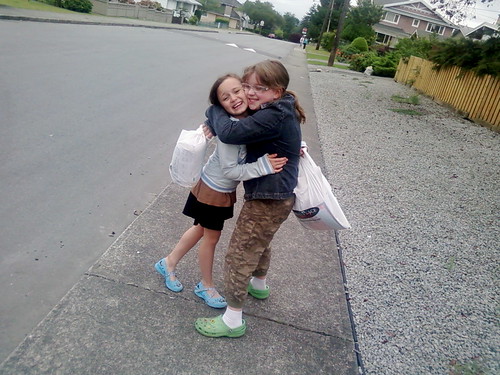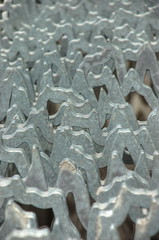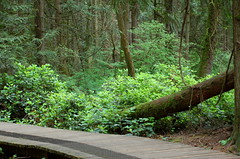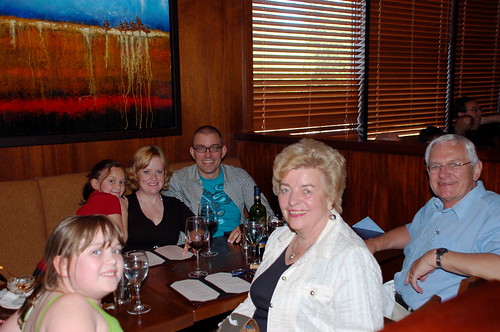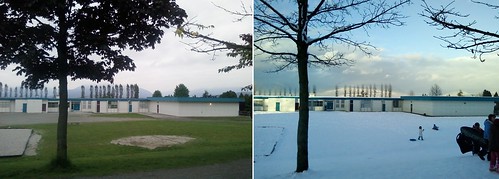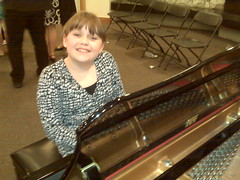Penmachine
30 June 2008
Rock from on high
One hundred years ago today, St. Petersburg, Russia, would have been annihilated by an enormous explosion—if the detonation had occurred less than five hours later than it actually did. But as it turned out, the event happened thousands of kilometres further east, smack dab in the middle of Siberia. St. Petersburg was lucky, saved by the rotation of the earth.
The fireball now known as the Tunguska Event was the mid-air explosion of an extraterrestrial object of some sort (link via PZ Myers), likely a meteorite or fragment of a comet—fairly big, perhaps 50 or 60 metres in diameter, like a condominium tower falling from the sky at several thousand kilometres per hour—which disintegrated violently in the atmosphere. The place is still a remote Siberian forest, several hundred kilometres northwest of Lake Baikal. Trees that fell then still lie on the ground a century later. The heat created microscopic glass beads in the soil. There would be no airburst of similar magnitude until the invention of the hydrogen bomb.
It took almost 20 years for a Soviet scientific expedition, led by Leonid Kulik, to visit the area and survey the still-extensive damage in 1927: while there was no obvious crater, trees had been stripped of their branches and bark, as well as flattened by the shock wave, in a region some 50 km wide. Had the Tunguska Event occurred in a populated area, tens or hundreds of thousands of people might have died.
It was nothing, of course, compared to other impact events on earth, such as those linked with mass extinctions in the more distant past. But I still wouldn't have wanted to be anywhere near it.
Incidentally, Tunguska shares its centenary not only with my 39th birthday today, but also with something else I'd probably prefer to steer clear of: the 45th birthday of Yngwie Malmsteen.
Labels: anniversary, astronomy, birthday, disaster, guitar, history
Geeky geeky geeky
Over at the Your Geekiest Photos photo pool that I set up at Flickr a few months ago, we have accumulated quite a collection, but it could be bigger. Don't forget to join up and add your own.
Dig deep into your archives—it would make a nice birthday present for me.
Labels: geekery, history, memories, photography
Today I am 39 for the first time
I don't think I'll become one of those reluctant to reveal his age. Hell, I'm damn proud of each further year I get at this point. So today I turn 39, for the first and last and only time. It will be a hectic day, with much packing and running around.
Why? Because tomorrow, Canada Day, July 1, my wife and daughters leave for a week at Disneyland, and I'm taking them, with our friend KA and her son, to the airport at 4:00 a.m. (!) for their 6:30 flight. A few hours later, I'll be back at the airport to drop off our friend Leesa for her return to Australia.
Then, as I begin a few days of solo living bachelor style, I have a couple of Canada Day parties I may attend, and maybe even a show by the Adam Woodall Band in the evening. That is, if I'm not so exhausted from the early wake-up that I just sleep away the rest of our national day.
So I won't reflect too much on my birthday. You can, however, read what I wrote at the end of June in 2007, 2006, 2005, 2004, 2003, 2002, and 2001.
My my. I have been at this blogging thing for awhile now.
And here, for no reason other than that I like it, is a picture of my daughters coming home from the last day of school:
It's summer, baby!
Labels: airport, birthday, family, holiday, travel
29 June 2008
Sticky Neurotic looks baked
 I don't play drums as often as I used to—I did it as a full-time job in the early '90s—but I am glad I still get to do it for money on occasion. Last night my band, The Neurotics, played a wedding in Chilliwack, one of Vancouver's eastern suburbs.
I don't play drums as often as I used to—I did it as a full-time job in the early '90s—but I am glad I still get to do it for money on occasion. Last night my band, The Neurotics, played a wedding in Chilliwack, one of Vancouver's eastern suburbs.
And you know what? When you play drums only occasionally and get home at 3:00 in the morning, your hands hurt the next day.
No, I was not actually stoned in the photo. I do notice that the wig fits much better now that I have very little hair.
Labels: band, music, neurotics, pain
27 June 2008
An author chimes in
Steve Ettlinger, author of Twinkie, Deconstructed, which I wrote about recently, left a comment saying that my blog post was his favorite review of the book.
In part that must be because I liked it, but it also seems that most other reviewers missed the winking irony in his use of Registered Trademark Symbols® throughout, which reminded me of Douglas Coupland's early-'90s novel Shampoo Planet. In that previous case the brands were made up, but the effect is similar: as a reader you feel a bit uncomfortable being hyper-aware of them.
I like that Ettlinger is keeping track of online reviews, in addition to those in traditional publications and media.
Labels: books, food, linkbait, writing
26 June 2008
Unexpelled
No, I didn't end up seeing Expelled. Our Aussie friend Leesa and I caught the Adam Woodall Band in West Vancouver instead, and it was a fun time. I'm sure I enjoyed myself more than I would have at the movie.
Labels: band, music, vancouver
25 June 2008
High-definition Fairview
Today I had a meeting with the trial nurse for my upcoming resumed chemo treatments next month, followed by a series of blood tests, an appointment with my oncologist and the nurse again, then a CT scan. In between, I had some time to kill, so I had lunch at White Spot, then took time to walk around the Fairview neighbourhood and experiment some more with high dynamic range (HDR) photography.
Here are the results:
For each photo, I set my Nikon D50 camera to take three bracketed exposures: one at the default exposure the camera estimates, one two stops darker, and one two stops lighter. Then I used Photomatix Pro on my Mac to assemble them into HDR images, then tone-map them into the pictures you see. It's fun.
Labels: art, cancer, chemotherapy, hdr, photography, software, vancouver
23 June 2008
Sayonara, "Search Engine"
A couple of months ago I noted that the Canadian Broadcasting Corporation has two technology-focused radio shows, "Spark" and "Search Engine," and that I couldn't always figure out how they were supposed to differ. (In the comments, Darren Barefoot noted that one way to tell is that "'Search Engine' almost always comes with a sense of righteous indignation, which gets a bit old after a while.")
It looks like CBC also wondered why they had both shows, and has now dissolved "Search Engine" as a radio show by having host Jesse Brown report on technology for other CBC Radio programs. This despite "Search Engine" being one of the network's most-downloaded podcasts. So there will still be a compilation podcast, and the blog will continue too.
That's not a bad solution. Of the two shows, I prefer Nora Young's lifestyle-focused "Spark" over Brown's more politically obsessed "Search Engine" anyway, and "Spark" is coming back in much the same form as before. "Search Engine" will be quite different, since Brown will be working on his own without a team of correspondents, producers, and researchers. We'll see how that goes.
It's worth listening to the last regular show of "Search Engine," however. In it, Brown interviews Canadian Industry Minister Jim Prentice about the lousy new Canadian copyright legislation currently before the House of Commons. Prentice doesn't come across well—but in this case, I think the righteous indignation is appropriate.
Labels: cbc, controversy, copyright, government, podcast, radio
22 June 2008
The best brainless, fun, hard-rockin' songs, according to Derek
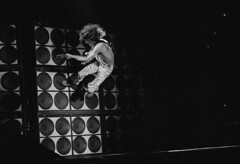 There's a certain type of rock-n-roll song that bypasses your intellect and goes straight for the gut—or a bit lower. One that makes you want to shake your ass, or your head, and sing along, even if you don't know the words, because the words don't matter all that much. They're dumb and sophomoric, anyway, or at least unintelligible—probably about sex or cars or girls or something.
There's a certain type of rock-n-roll song that bypasses your intellect and goes straight for the gut—or a bit lower. One that makes you want to shake your ass, or your head, and sing along, even if you don't know the words, because the words don't matter all that much. They're dumb and sophomoric, anyway, or at least unintelligible—probably about sex or cars or girls or something.
Such a song features guitars, bass, drums, and singing, but probably no keyboards and definitely no strings, horns, or children's choirs. It probably has about three chords, or sounds like it does. The guitars are distorted and loud, and there's almost certainly a guitar solo too, but a short one. You want to turn it up. You know what I'm talking about.
Here is my top 10 list of such songs. Yeah, they're all very mainstream, and you may disagree with me, but I don't care—go ahead and leave a comment if you have further suggestions. I'll include some of my own runners up in a later post. It's a stupid list of stupid songs, which is the reason they're great to begin with:
The Breeders, on the other hand, say, "Koo koo," or, more thoroughly, "Hey now, hey now/Want you, koo koo/Cannonball." Their song is built on a monster bass riff, vocals laid down as if sung through telephones and bullhorns, squeals of feedback, and thick, chunky guitar chords. Plus a drum fill that launches into the chorus like a machine gun, not a cannonball.
Joey Ramone is hiccuping like an amphetamine-fueled Buddy Holly about kids piling in the back seat and losing their minds, Johnny is buzz-sawing his barre chords, and Dee Dee and Tommy pummel away in the background. Despite the disappointing charts and record sales, I'm sorry, "Blitzkrieg Bop" is way better than Steely Dan or the Doobie Brothers.
Yet he was also taking a dig at the very kids who joined in singing, "Our little group has always been/And always will until the end." Yeah sure, teenagers always think so: oh well, whatever, nevermind. The guitar solo exactly duplicates the verse melody too, so it's sort of an anti-solo. Yet you don't need to know any of that, and I'm not sure Nirvana really wanted to you think about it very much, since the song rocks out no matter what.
That's the same reason Van Halen (see below) released a version as their first single in 1978. And while the Beatles may have sung "oh yeah!" a little earlier, no one has ever snarled it with more conviction than Ray Davies. Sure, the Rolling Stones might have seemed a tad dangerous back in '64, but I'm sure whenever kids put "You Really Got Me" on the turntable, it's what really scared the parents.
It wasn't as big a hit as "You Shook Me All Night Long," but that doesn't matter either—because there's more power and good-time boogie in the first chord of "Back in Black" than most bands put out in their entire careers. The clincher is the sing-along chorus: "Ba-a-a-a-ack! Ba-a-a-a-ack! Back in black, yes I'm back! In! Black!" Put away your schoolboy short pants. You're done.
Eddie's lithe little guitar solo is neck-snappingly brief, but still manages to tell a whole story. It starts off with a stereotypical string-bending riff any guitarist could play, then skyrockets off into impossibly fast finger-tapping, whammy-bar–wrangling madness before settling down into the gritty, slinky background of the spoken-word bridge, in which Roth intones the immortal words, "We're runnin' a little bit hot tonite/I can barely see the road from the heat comin' off it/Ah, you reach down/Between my legs/Ease the seat back..." In the background we hear the revving engine of Eddie Van Halen's Lamborghini, which was apparently backed into the recording studio (!) for the purpose.
Then we're into a building, building, building setup that climaxes with spot-on a capella harmonies from the whole band singing, "Ain't no stoppin' now!" What is the sing-along chorus? One word, over and over: "Panama! Panama-uh!" Who can forget the video too, which is like a compendium of pop petal clichés, including Dave riding through the streets of Los Angeles on his motorbike, mane of hair flowing in the wind?
And we're still done in under four minutes. I bow before you, Van Halen. If there is a more perfect song for a hot drunk summer night, I can't think of it.
After much discussion in the comments to this post, I must also add an honourable mention for Sweet's "The Ballroom Blitz" (I can't figure out which other tune to replace with it), from 1973. Brian Connolly's singing is so off-the-hook frenzied, so Rocky Horror Picture Show over the top that it's almost yodeling, and as Bob noted in the comments here, it's hard to beat an intro like, "Are you ready Steve? Andy? Mick? All right fellas, let's GOOOOOOOOOOOOOO!"
Labels: band, linkbait, lists, music, radio, video
21 June 2008
Quandary: should I see "Expelled" or not?
 Back in March I wrote about the dumb behaviour of the people who made the film Expelled: No Intelligence Allowed. Now, probably because of that posting and my other entries here about science, I've been invited by distributor KinoSmith to attend a press screening of the movie here in Vancouver next week. I'm wondering if I should bother to go.
Back in March I wrote about the dumb behaviour of the people who made the film Expelled: No Intelligence Allowed. Now, probably because of that posting and my other entries here about science, I've been invited by distributor KinoSmith to attend a press screening of the movie here in Vancouver next week. I'm wondering if I should bother to go.
Propagandumentary
First, some background about Expelled. It is a purported documentary, supposedly a Michael Moore–style critique of the current academic establishment of evolutionary biology. I enjoy a good intellectual debate, especially about topics as important to us as the development of life on earth, so if that's what Expelled really were, it might make an interesting film.
However, the evidence indicates that instead it is, in the words of New York Times reviewer Jeannette Catsoulis , "one of the sleaziest documentaries to arrive in a very long time [and] a conspiracy-theory rant masquerading as investigative inquiry." (That is the first line of her review.) Here, for instance, is a quote about Expelled from narrator Ben Stein:
Love of God and compassion and empathy leads you to a very glorious place. Science leads you to killing people.
It's fine for people to disagree, but a blanket line like "science leads you to killing people" is not only wrong, it's profoundly simplistic and inflammatory. Would religious people be likely to attend a movie promoted by lines like, "religion leads you to killing people"? I suspect, for instance, that many have been put off reading Christopher Hitchens's book God Is Not Great, with its chapter, "Religion Kills." (I haven't read it either, but not for that reason.)
Is it worth my time?
Okay, fine, so I'm not disposed to like the movie, but am I being closed-minded about it? Here's another issue. Totally beyond its mistaken premises, its misleading of interviewees, its senseless invocation of Hitler and Stalin as inevitable consequences of accepting natural selection, its plagiarism, and its promotion of intelligent design as a supposedly scientific idea instead of as a front for (mostly biblical) creationism, Expelled is also, by all indications, a lousy movie: poorly made, badly edited, patronizing, disorganized, and often dull.
Anyway, here's my quandary. I'm interested in finding out what all the fuss is about, so part of me thinks I should use the free double passes that arrived in the mail yesterday, and take three friends to see Expelled next Thursday. I wouldn't pay to see it, because I don't think the filmmakers deserve my money, but these are free tickets, and it's actually costing them for me to go.
On the other hand, I still remember seeing Highlander 2 back in 1991. That movie was so bad that it somehow made its predecessor worse: in my mind, it tainted the first Highlander film, which I had enjoyed. I get the feeling that Expelled is similarly bad, the kind of film that makes you wish you'd never seen it and had those few hours of your life back.
Probably not
We have a friend visiting from Australia for a couple of weeks, and our family would like to spend time with her. My daughters' final piano lesson is that same day. I suspect I have many better things to do, such as hanging out in my back yard, or maybe having a nap.
So, after my fine promotion here, does anyone want four free tickets to see Expelled next Thursday, June 26, 2008, at 7:00 p.m., at Tinseltown in downtown Vancouver? The tickets say, "Arrive early as theatre capacity is limited and seating is not guaranteed," by the way. Let me know if you want them, even if just for the hell of it. (Pun intended.)
Labels: biology, controversy, creationism, intelligentdesign, linkbait, movie, naturalselection, religion, science
19 June 2008
The green bog
 I accompanied my older daughter's school field trip to Burns Bog in Delta, south of Vancouver, today. We had fun, and managed to avoid any heavy rain.
I accompanied my older daughter's school field trip to Burns Bog in Delta, south of Vancouver, today. We had fun, and managed to avoid any heavy rain.
I also took the chance to create some more high dynamic range (HDR) photos. That involves taking three or more pictures at different exposures, and then combining them in software using a technique called tone mapping.
You can see what that does below.
On the left you can see my camera's calculated single optimum exposure, the "best pick" the camera would normally make. Nothing wrong with it. But on the right is the HDR version I created, combining the left-side exposure with two others, one brighter and one darker:
The extra vividness of colour I chose to put into the tone-mapped HDR is obvious, but if you examine the large version, you can also see a lot more detail in the shadows and highlights of the image. That's the high dynamic range we're talking about—in a normal photo, some of the shadows might be totally black, while some of the highlights might be blown out to total white.
Tone-mapped HDR photos involve a lot more decision making than traditional pictures, because depending on how you manipulate the image, its appearance can vary widely, from slightly enhanced (the way filters and darkroom work used to punch up film images) to strangely surreal (more like cross-processed, solarized, or otherwise highly altered film images).
So far I've been photographing nothing but plants in HDR for some reason, but I will play with the technique some more and post additional pictures to my Flickr HDR set.
Labels: geekery, hdr, park, photography, school, vancouver
18 June 2008
Buying your first serious digital SLR camera
 I get emails out of the blue sometimes, and yesterday a guy who found me via Flickr asked my advice on buying his first serious digital SLR (single-lens reflex) camera. He's already quite a good photographer, with a keen eye, and he's trying to decide between the Nikon D300 and Canon EOS 40D.
I get emails out of the blue sometimes, and yesterday a guy who found me via Flickr asked my advice on buying his first serious digital SLR (single-lens reflex) camera. He's already quite a good photographer, with a keen eye, and he's trying to decide between the Nikon D300 and Canon EOS 40D.
He likes the Canon's interface, but prefers the features of the D300, as well as the more vivid colours it produces (at least in JPEG mode). He wants low noise, good low-light performance, and good ability to take landscapes, high dynamic range (HDR) photos, and macro (closeup) pictures.
When you're starting out buying an SLR, what you're doing is committing yourself to a camera system, particularly with lenses. Chances are you will keep and use the lenses for much longer than you use that camera. For instance, I have a Nikon D50 I bought in 2006, but my lenses include a zoom that I bought in 1995 for my old film Nikon, and which still works great. I've been using Nikon SLRs since the early 1980s—had I chosen Canon or some other camera back then, I'd probably still be using that brand, just because of the inertia.
Both Nikon and Canon are good choices—but don't forget Pentax's K20D (Pentax provides some of the best values in both SLRs and quality lenses these days) and even Sony's A700 (Sony took over Minolta's camera business, and offers very nice Zeiss lenses too, some of the best available). I'm not a fan of the four-thirds system from Olympus and Panasonic/Leica, but you might like it.
The D300 is about 50% more expensive than the 40D (around $1800 Cdn vs. $1300 Cdn), so that might make the decision for many people. (The closest competing Nikon is actually the aging D80.) One way that price difference could affect your decision might be with lenses: if you can only afford an expensive body (like the D300) with cheaper lenses, you'd be better off getting a less expensive body (like the 40D) with better lenses like Canon's top-end L series. Again, the lenses will be around your kit longer than the body.
And for any camera you get, rather than buying yourself a standard zoom lens, I would recommend getting one or two good-quality prime (non-zoom) lenses instead. They are better optically, faster (i.e. have a larger maximum aperture letting in more light), and will also make you think about your compositions more carefully.
So I said to my questioner that if he doesn't have a brand preference for other reasons, and if he can afford the Nikon D300 with a quality lens or two, then I'd recommend it over the Canon 40D. The D300 offers excellent low-light performance, an amazing LCD screen (much better than anything Canon has), and lots of other features. Not that there's anything wrong with the 40D, but by most objective measures the D300 is superior.
As far as lenses go, if I were starting from scratch, I'd get a basic fast prime like the $140 Nikon 50 mm f/1.8 or the $500 digital-only Sigma 30 mm f/1.4. For a second lens, I'd look at either a general-purpose stabilized zoom like Nikon's well-reviewed $750 18-200 mm, or (more likely in my case) a moderate telephoto prime that can also act as a macro lens, such as Nikon's $900 Micro-Nikkor 105 mm f/2.8. If I had more money to spend, I might get both of those, or go crazy and buy the $1500 manual focus Zeiss Makro-Planar 100 mm f/2.
Canon has similar standard prime, telephoto-style macro, and zoom lenses. So do Pentax (prime, macro, zoom) and Sony/Zeiss (prime, macro, zoom, or Zeiss zoom).
It would be a pleasant luxury to be starting an SLR system from scratch, and to have maybe $4000 to spend on it. But no matter how you start, if you're a photography enthusiast, you'll get more lenses and other accessories (flash, battery grip, tripods, etc.) over time. Just don't cheap out with your lenses to start, and you'll be happier in the long run.
Labels: canon, gadgets, geekery, hdr, leica, macro, nikon, olympus, pentax, photography, sony
17 June 2008
Where to get a door trimmed in Vancouver
We had carpet installed in a basement room last year, and it was just thick enough that we had to remove the door because it would no longer close—it ran into the carpet at the bottom. The simple solution was to get the door trimmed at the bottom to fit, but we never got around to it.
Until today. We have a guest coming from Australia, and she's staying in that room of a week and a half. It would be nice if she had a door. But it turns out that finding someone to trim a door in Vancouver is no easy task. Home Depot doesn't do it. Competitor Rona does at their big store on Grandview Highway, but their machine was broken. I called and called around without much success.
With the right tools and rig, I could do the job myself, I suppose, but it would take awhile and the risk of misaligning or cracking something is pretty high in my only semi-handy household. Fortunately, the House of Doors on West Broadway near Alma is happy to take my money and shave half an inch off the bottom of the door for us. We'll take it out there tomorrow morning. Now you know.
UPDATE (June 18): Yup, worked great. I dropped the door off at the back of the store, came back 20 minutes later, paid $20, drove home, and re-mounted the door. No problems.
Labels: home, homedepot, repairs, vancouver
16 June 2008
An easy way to donate for cancer research, and butts
Of all the charity events out there, the Underwear Affair is now the closest to me personally, because it is, as Gillian notes:
...a run/walk to raise funds and awareness for cancers of the unmentionable areas: cervical, prostate, ovarian, testicular, colon, and other words I don’t say much on this blog despite having my mind in the gutter most of the time.
Kidding aside, I hear stories now and again of people who had some problem down there but were too embarrassed to go see a doctor, and how, in a way, they died of this embarrassment. So maybe it’s better to take the stigma out of talking about down there so that people will feel comfortable in seeking treatment for their problems and telling others about it.
Also, talking about butts is fun, everyone should try it. Especially in front of their mothers. At dinner.
She tells me that something like half of the funds she raised last year came from people who know me and my butt cancer woes. I find that pretty amazing, but maybe we can do even better this time? Go to her donation page and chip in.
The run itself is July 12, which is two days before I plan to start my next round of chemotherapy.
Labels: cancer, chemotherapy, exercise, friends, science
15 June 2008
Father's Day
We didn't get the whole clan together (my wife's parents couldn't make it today, for instance), but we did have a very nice Father's Day dinner at the Keg Steakhouse in Burnaby this evening:
From left to right, those are my daughters, my wife, me, my mom, and my dad. We had steak. And dessert. Very full. Yum. It was particularly satisfying since it was a lovely sunny day, and my wife and I spent the morning painting one set of front steps at our house. She also cleaned and stripped the paint from the other set.
Labels: family, food, home, vancouver
14 June 2008
Getting good sound on your audio podcast
I co-host Inside Home Recording, a long-running audio podcast about recording music and other stuff in your home or project studio. Earlier this year we launched InsideHomeRecording.tv, a companion video podcast that offers short tutorials on the same subject. I just put together my first episode, which shows the process I use for my wife's podcast, Lip Gloss and Laptops, to get good sound reasonably efficiently and cheaply:
You can download IHR TV #3 (H.264 video) or watch it at Blip.tv, Vimeo, and Viddler. A shorter version is also on Revver, YouTube, MySpace, and Facebook. You can receive IHR and IHR TV updates at twitter.com/ihr. And you can subscribe to either the original IHR audio show or to IHR TV.
Let me tell you, though, video is hard. I constructed this episode using a combination of Final Cut Express (to import high-definition video from our AVCHD camcorder) and iMovie '06—which is an old version of that program—for editing. There was lots of importing and exporting, syncing and chopping up and reassembling, and general mucking around with stuff to get it to something I liked.
The reason I undertook such a convoluted process is that Final Cut Express is a big, hairy, complicated program. It does more than I need, and is nearly impossible to sit down and figure out by using it, while the "re-imagined" new iMovie '08 is too simple, designed with a minimalist set of features for absolute video beginners, which even I am not. But iMovie '06 is the perfect mix for me. Even so, it took hours and hours to put the episode together.
My next one will come together faster, because I've figured out some stuff, but I have a new respect for people who make videos, TV shows, and movies for a living—especially editors.
Labels: audio, editing, insidehomerecording, lipglossandlaptops, podcast, video
13 June 2008
The machine
 In 1992 I'd already been on the Internet for a couple of years, but most people had never heard of it. Personal computers with mice and windows were widespread, but the Web was just being invented, and didn't have images on it yet.
In 1992 I'd already been on the Internet for a couple of years, but most people had never heard of it. Personal computers with mice and windows were widespread, but the Web was just being invented, and didn't have images on it yet.
That year, the U.S. Public Broadcasting Service produced a five-part documentary series called The Machine That Changed the World, which was about the history and impact of electronic computers. I would have loved that show, but I never saw it at the time. Fortunately, Andy Baio of waxy.org has digitized the whole thing and made it available for download. I watched it over the past few days.
The three history episodes that begin the series are still very relevant, and particularly useful because they include interviews with many early computing pioneers, some of whom have died in the intervening 15 years or so. The fourth, about artificial intelligence, is both refreshing and dismaying, because in a decade and a half very little has changed in the field of AI—making computers think seems to be a harder and harder problem the more we learn.
You'd think that the final episode, about computer networks, would be the most out of date. After all, the '90s and our current decade are in many ways defined by the rise of the Internet (which gets a brief mention on that show, in the context of how it helped debunk cold fusion in the scientific community). Yet that show is intelligent and has good foresight about how electronic communications can change human societies.
The two things I noticed the most about the series are that the concepts of pirates and malware and cyber-attacks are hardly mentioned—although privacy concerns make up a big part of the final episode—and that pretty much everyone types on clackety, loud, heavy-duty keyboards that many modern geeks would lust after.
What is clear from The Machine That Changed the World is that the computer industry had largely found its solutions to fundamental hardware and software problems by the early 1990s: the Macs and PCs everyone used by then are obvious close relatives of the computers we still use today. By contrast, personal computers 15 years before that, in the late '70s, would be unrecognizable to my kids, and even those were terrifically advanced compared to their room-filling vaccum-tube predecessors of the '40s and '50s.
What changed is now we use them. The final episode takes pains to explain what a modem is, and how it connects to a phone line. It reveals in amazement that "over a thousand" senior citizens in North America communicated by email over "SeniorNet," and that a modem user could connect to Japan, Estonia, and Norway in the course of ten minutes—today we could do that in a web browser with a few clicks, but more remarkably, we probably wouldn't know or even care where the computers we connect to are.
I watched most of the show on my iPod Touch, which was appropriate. Watching the early programmers wrestle with mazes of wire to set up ENIAC, I tried to imagine how much more computing power I was holding in my hand, but the multiplier was too large. Even more amazing, in a way, was that despite their familiarity, the hulking, multi-thousand-dollar desktop computers on the desks of people interviewed for the show were still less powerful than my little handheld media player.
Labels: geekery, history, telecommunications, television, web
12 June 2008
Chemo brain
I've been absent-minded recently, in a different way than when I first got diagnosed with cancer last year. I regularly forget things, or misplace them, in a way I didn't before. Just in the past week, without noticing, I somehow left a tiny SD memory card with some important podcast audio on it sandwiched between a Nintendo Wii disc and the case for a different disc in our den. It took hours to find.
And in the past couple of days, I was searching endlessly throughout our house for my heavy-duty camera tripod, which I bought last spring. It's not small—about a metre long—and made of steel, not to mention being in a big green nylon bag. Not something you'd think would be easy to lose. But it turns out that, after taking it to the Vancouver Sun Run with my band in April, I packed it in the bottom of my drum bag, under a bunch of cymbal and drum stands. I didn't recall that at all, until I had a hunch this afternoon.
It's also not unusual for me to forget something right after planning to do it: taking out the trash, grabbing a book to return it to the library, finishing unloading the dishwasher. You could attribute that to normal aging, but I am only 38. My wife calls it "chemo brain," and noted to me that it (under the name post-chemotherapy cognitive impairment) is a well known condition among chemotherapy patients. Most of the research talks about long-term effects on memory, learning, and coordination after treatment, not problems during it, like mine.
Other memory conditions apparently benefit from mental exercise: solving problems and keeping your mind active. That's something many chemo patients might not do, especially if we feel shitty a lot of the time and (like me) are off work. But I think one thing that might help me keep ahead of chemo brain is the various activities I continue to pursue that require thinking. Things like music, podcasting, photography, even sorting laundry or emptying the dishwasher (when I remember to do that).
At least it's a good excuse to geek out. And a good reason to do chores too.
Labels: cancer, chemotherapy, family, home, memories
11 June 2008
Contentment
There is nothing so relaxing as watching my two daughters and my wife as they sleep.
10 June 2008
Photos from ideas
Here are a couple of photo collages. The first one shows two views from the same place in my kids' schoolyard, one from today and one from this past winter:
The second came to me via Jodi, who explains at her blog how to search for and assemble your own similar Flickr meme collage:
1. Penmachine in action, 2. 2006 07-22 HOOK typeB [16], 3. talking to air, 4. alive and bright, 5. Lavender crème brûlée with fresh berries, 6. hawaii lava, 7. The Glenlivet, 8. Kari Byron, 9. Auroville 014 - Colour Purple, 10. St. George's School - 1931, 11. Disco Girls - 5, 12. derek jarman's gaff
P.S. I answered the questions in reverse order.
Labels: ego, flickr, linkbait, meme, photography, snow, vancouver
09 June 2008
Book review: "Twinkie, Deconstructed," deconstructed
 Anyone who's ever eaten a Twinkie remembers the experience, even if it's been years. The textured, firm, sweet dough combined with the intense vanilla creme (not cream, mind you) filling is distinctive and, especially when you're a kid, delicious, yet obviously somehow sinful and wrong and unnatural at the same time.
Anyone who's ever eaten a Twinkie remembers the experience, even if it's been years. The textured, firm, sweet dough combined with the intense vanilla creme (not cream, mind you) filling is distinctive and, especially when you're a kid, delicious, yet obviously somehow sinful and wrong and unnatural at the same time.
While I was in hospital last week, my wife brought me Steve Ettlinger's book Twinkie, Deconstructed (buy using my affiliate code at Amazon Canada or U.S.A.). It's a perfect "Derek's sick" book: a sort of "science lite" non-fiction tome that's fascinating, informative, and non-polemical while still making a political point. I finished it in a little over a day.
The concept is brilliant. Prompted by a question from one of his kids, Ettlinger, a long-time science and consumer products writer, tells a story of traveling around the world to find out where each of the dozens of ingredients in a Hostess Twinkie comes from—in the order in which they're listed on the package. In doing so, he visits a lot more factories than farms, and encounters many more industrial centrifuges than ploughs.
Some reviewers think that Ettlinger got co-opted into the "Twinkie-Industrial Complex" (as he calls it) during the writing of the book. They think that he is too accepting, too uncritical, and indeed too friendly to the various large corporate interests who show him (or, in many cases, refuse to show him) around their facilities and processes. But I think he's smarter and more subversive than that.
Here's something from page 195:
In an undisclosed location, perhaps in an industrial park near Chicago, maybe in rural, central Pennsylvania, possibly in riparian Delaware, in a plant full of tanks, railroad sidings, and a maze of pipes and catwalks, big, stainless steel vats are filled with fresh, hot, luscious, liquefied sorbitan monostearate.
Or check out this label-text Kremlinology from page 255:
...while it seems that not one natural color is use in Twinkies, sometime the label has said "color added," which would make me suspect that annato, the butter and cheese colorant that is popular with [Hostess's] competitors, is indeed in the mix. But their punctuation indicates otherwise. "Color added" is followed by "(yellow 5 red 40)" which would seem to indicate grammatically that they are the only colors involved.
One of the most obvious stylistic effects throughout the book is that whenever Ettlinger first mentions a trademarked product, he adds the registered trademark symbol: Yoo-hoo® Chocolate Drink, PAM® cooking spray, Clabber Girl®, Davis®, and Calumet® baking soda, and so on. Normally you'd only see things written that way in a press release or corporate brochure.
You might think he was simply pressured by company lawyers, but when I read the book every trademark symbol seemed to me like a wink from the author, an unavoidable reminder that while he's breezing along in his personal, gee-whiz style, he hasn't forgotten that the process of Twinkie-making is huge and industrial, one that has only a little to do with baking and nourishment, and a lot with multinational chemical firms and drill rigs and mines and massive tract farms.
Twinkie, Deconstructed is no Silent Spring, or even Super Size Me. It's neither a manifesto nor a satire. It's not horrified at what Twinkies are made of—because ingredients originating from petroleum or minerals rather than food plants or animals is part of the Twinkie legend. What's surprising is only how far some of those ingredients have to travel, and how extensively they have to be mangled, reprocessed, ground, dissolved, flung, and dried before they get used in even minute quantities to bake those little cakes.
Ettlinger's book is, I think, more effective because he doesn't politicize it overtly. He simply tells us, repeatedly and relentlessly, about conveyor belts, pipes, pressure vessels, railroad cars, noxious chemical reactions, huge stainless steel tanks, monstrous earth-moving equipment, and what obviously must be enormous quantities of energy used in all those processes. He talks just as blithely about factories that refuse to tell him where their ingredients come from at all as he does friendly chemical engineers who show him around less secretive facilities. You can draw your own conclusions.
I did find myself wishing, at the end, that he had calculated how much energy a single Twinkie consumes in its manufacture—how much oil or coal or gas, or how many kilowatt-hours of electricity, it takes to bring all those ingredients together. And I was surprised that, after nearly 300 pages of background, Ettlinger never actually describes step-by-step how a Twinkie is made at the Hostess bakery.
But Twinkie, Deconstructed is a fun read. Whether you feel safe eating a Twinkie afterwards is a message you can safely infer from the book, rather than having to be clubbed over the head with it.
Labels: books, food, linkbait, writing
08 June 2008
Back to the city
I know it's being marketed as the ultimate chick flick, so that no straight guy is ever supposed to want to see it, but since I liked the Sex and the City series, there was no reason not to check out the movie too. My wife invited me and our pal Tod to head down, and we all liked it.
The advertising somehow avoided it, but the film preserved the humour of the TV show, which was the most important thing for me. I think the filmmakers packed in a little too much into the movie, which seemed to put a whole TV season's worth of plot into two hours. Keep in mind too that in the world of Sex and the City, money works about as realistically as physics do in Iron Man or Transformers. And, unfortunately, I think the key moment of the central conflict of the film held back just slightly too much—it made many other things seem like an overreaction later on.
But if you liked the show, you'll like the movie. There you go.
07 June 2008
Derek and the Amazing Technicolor Vomit
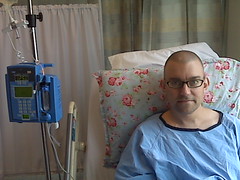 I've noted before how remarkable my wife is, both as a person and as a spouse. She's also amazing when I'm sick and when I'm not.
I've noted before how remarkable my wife is, both as a person and as a spouse. She's also amazing when I'm sick and when I'm not.
This week she had to deal with my being nastily ill once again: she not only shuttled me to emergency wards three different times and sat up with me there till insane hours of the early morning, but also kept the kids fed and clothed and schooled and loved, came to visit me with supplies (including some amazing lip balm), ran the house, went to work, and made sure everyone important knew what was going on with me.
I'm home now, but it was a gross week. After my overnight trip to Burnaby General Emergency (which wasn't too helpful) and visit to my oncologist (slightly more so), we went home. But I couldn't stay there. My intestinal pain got worse than ever (which is pretty darn bad), and we zipped down in the car to the emergency ward at Vancouver General Hospital instead—it is near the Cancer Agency, and has many more resources for handling both colon cancer and intestinal blockages.
I was at VGH for four days, and just returned home a couple of hours ago. During that time there was vomiting, lots of morphine injections, several X-rays, plenty of intravenous fluids, and no food or drink for the first couple of days. By Thursday things were improving. But man, overall it was brutal.
Now that I'm back on the couch in the house, I've decided to declare email bankruptcy for the week, purge my Gmail inbox (current count, 899 unfiled messages), and start over from scratch in the next couple of days. So if you emailed me recently, I won't reply now, sorry.
But I will get my wife some sort of nice treat in thanks for everything this week, that's for sure.
Labels: cancer, family, hospital, love, morphine, pain
03 June 2008
Let's twist again, like we did last summer
My hospital visit a few days ago wasn't the last of it. I was back in Burnaby General's Emergency department last night once more, this time overnight. More harsh intestinal cramps (with bonus vomiting), almost certainly a sign of some sort of blockage, like the one I had right after my surgery last summer.
First thing today, my wife drove me directly from Burnaby Hospital to the B.C. Cancer Agency, where we met with my oncologist. He prescribed morphine and bed rest, and has me coming back tomorrow for some IV fluids. I'm home now, but I may get checked into the Cancer Agency ward for monitoring for a few days while my bowels rest up. I'm hoping to avoid another tube up my nose, but you never know.
At least this time my weight is back up, so if I lose a bunch of pounds I won't be skeletal.
Labels: cancer, fatigue, hospital, ileostomy, pain
02 June 2008
The hard drive grumblies
A few weeks ago, I replaced the old wireless router in our upstairs den with a new Apple AirPort Extreme base station, which has generally worked great. One extra benefit of the design is that, like Apple's similar Time Capsule, I can use it as a wireless backup device device by hooking up an external USB hard disk, like this:
The disk I use is a 500 GB Western Digital MyBook, perched to the left of the base station itself. If you look closely at the photo, you'll notice that the disk enclosure is sitting on a folded cloth napkin.
Here's why. The shelf all that networking gear sits on is made of light wood, and sits loosely on a wooden lip around the edges of the inside of the den closet. The other side of the closet's back wall is the south wall of our bedroom.
So, after I set up automatic backups for our various Macs using Time Machine and other tools (apparently not officially supported in this setup, by the way!), whenever the hard drive was active (especially at night), our bedroom wall would rumble disconcertingly as the disk mechanism chugged away. The shelf and the closet drywall were acting as a big soundbox amplifier.
And so, the napkin, my half-baked attempt to damp down the vibrations from the disk mechanism. It sort of works. Now, when the drive is active, the wall makes something more akin to subtle stomach-growling noises, rather than louder rumbling. During the day, that's fine, but at night it's still prone to keeping us awake.
The temporary solution has been to make sure backups occur during the day when it doesn't bother anyone. But I still must unhook the USB drive at night to avoid the grumblies, during what seem to be random administrative disk accesses (perhaps search indexing) that occur anyway from time to time. But I'd rather not do that. I'm considering putting some foam under the edges of the shelf itself, or maybe moving the whole setup to different, less resonant part of the closet.
Wow, this sure is a first world problem.
Labels: apple, backup, geekery
01 June 2008
Recital
My daughters' piano and voice teacher Lorraine has dozens of students, and at the end of each school year she holds a formal recital, where nearly all of them perform a piece—or two or three—over the course of several hours at the Shadbolt Centre for the Arts in Deer Lake Park, near where my wife and I were married:
It's not the dreary stereotype of a piano recital at all. There are lots of jokes and laughs, kids give their teacher big hugs, and there is dessert and coffee at the end. At tonight's recital, my wife and I were there, as were both her parents and mine. I felt gladder than ever to attend—I missed last year's event because of pre-surgery radiation side effects. Despite lingering pain from my intestinal incident a couple of days ago, I was still able to make it down and enjoy the music.
Watching kids ranging across ages (from kindergarteners through university students, and even a grey-haired adult or two) play or sing the music they've learned almost brought me to tears a couple of times, such as when my older daughter sang the Beatles' "Let It Be" for the crowd, or her younger sister ended her nursery rhyme medley with a huge smile on her face.
When I quit music lessons when at age 12, my dad told me my skills were nevertheless good to have, because you can never be sure when you might need to play music on the street to eat. He was right: I ended up (by choice) making a full-time living as a musician more than a decade later—including occasionally busking downtown to pay the bills.
I don't know if my daughters will ever do that, but the joy of playing music is enough in itself. Plus free trophies and candy too.
